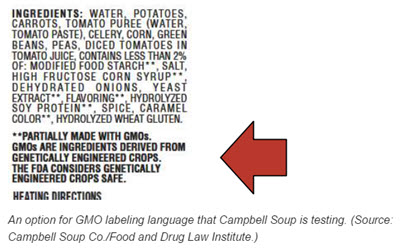WASHINGTON, May 6, 2016 - With the U.S. Senate still at work on an agreement on biotech labeling, a major food company is rushing ahead with research on possible labeling language that could serve as an alternative to the wording required by a Vermont law. The Campbell Soup Co. is testing as many as nine to 10 different labeling combinations with consumers to see which one would satisfy their needs while also conveying the safety of the technology.
The company plans to share its research with other companies with the goal of having a label to propose to the federal government should Congress preempt the Vermont law and mandate development of new language, company officials say. If Congress fails to agree on a preemption bill, the company may ask Vermont to adopt the language, the company’s chief lobbyist, Kelly Johnston, tells Agri-Pulse.
Campbell broke ranks with the rest of the food industry in January and announced that it was going to voluntarily label its biotech products. For the time being, the labels use the language required by Vermont: “Partially produced with genetic engineering.” But company officials say there are a number of problems with that language. One is that consumers prefer the term “GMO.” Another is the lack of information about biotechnology.
One of the labeling versions that Campbell Soup is testing says this:
“Partially made with GMOs. GMOs are ingredients derived from genetically
engineered crops. The FDA considers genetically engineered crops safe.”
Steve Armstrong, chief food law counsel for Campbell, briefly outlined the
company’s plan to a conference of industry attorneys Thursday. “No matter what
happens in Congress, or the other states, we are going to label for GMO,s and I
would argue we’re going to come up with best GMO label out there,” Armstrong
said.
His company also will be studying consumer reaction to the Vermont labeling to gauge whether there is resistance to the products.
As the food industry lobbies for a GMO preemption bill, officials also continue to prepare for the Vermont law taking effect in July. One glimmer of good news is that the state legislature is moving legislature that would prevent private rights of action against companies until next year, says Karin Moore, general counsel for the Grocery Manufacturers Association. Under the law, consumers are allowed to file complaints over products they think are mislabeled.
CRP expansion raises cost, industry concerns. Agriculture Secretary Tom Vilsack has added his voice to calls to expand the Conservation Reserve Program. But the idea is certain to get push back from grain traders, and it also raises the issue of how to pay for it. The 2014 farm bill cut the cap on CRP from 32 million to 24 million acres to help fund other programs.
Sportsmen’s groups are likely to call for a “significant” increase in CRP in the 2018 farm bill, says Ariel Wiegard of the Theodore Roosevelt Conservation Partnership.
But the National Grain and Feed Association, whose member companies worry about the impact of idling land on commodity prices, says in a statement to Agri-Pulse that the CRP cap should not be adjusted in response to market prices or fluctuations in landowner demand. The program should instead be focused on “demonstrable environmental benefits while still allowing U.S. agriculture to continue to grow and compete.”
One way to address the cost of expanding CRP is to shift from the temporary set-aside approach to longer-term easements, says Ferd Hoefner, policy director for National Sustainable Agriculture Coalition. “Over time, that would reduce the cost of the program to the taxpayer while increasing the environmental value of the program for soil, water, wildlife, and climate improvements,” Hoefner says.
USDA will enroll about 800,000 acres in the program this year. About 23.8 million acres are currently erolled, but 1.7 million acres are in contracts expiring this year.
FAO: Food prices trending up. Global prices for key food commodities have risen for the third month in a row after four years of decline, the UN Food and Agriculture Organization reports. FAO's Food Price Index rose 0.7 percent in April largely because of a 4.1 percent in the average price for vegetable oils. Palm oil prices are surging because of forecasts for low production this year.
Grain prices rose 1.5 percent in April because of strengthening prices for corn. Meat prices rose 0.8 percent because of growing U.S. demand for Australian beef, according to FAO. Even with the recent increases food prices are still down 10 percent below the level a year ago and more than one-third below the highs in 2011.
Biodiesel industry leader stepping down. Joe Jobe is stepping down as CEO of the National Biodiesel Board after 17 years. Jobe started with NBB in 1997 and took over the top job two years later. During his tenure there, industry production has grown from 200,000 gallons to a projected 2 billion gallons this year.

